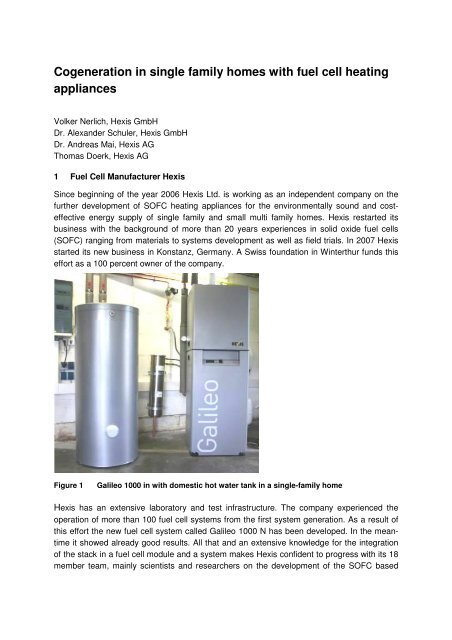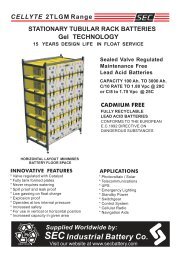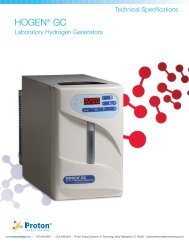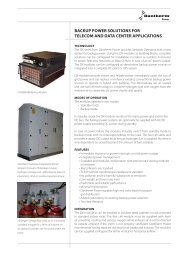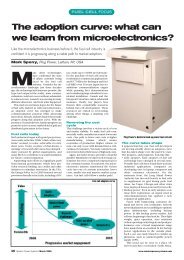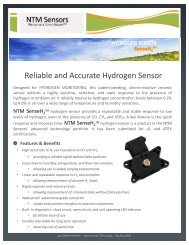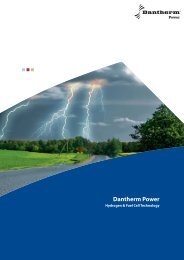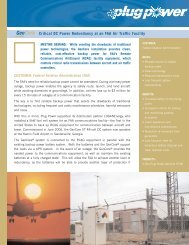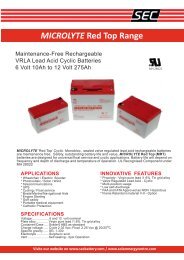Cogeneration in single family homes with fuel ... - Fuel Cell Markets
Cogeneration in single family homes with fuel ... - Fuel Cell Markets
Cogeneration in single family homes with fuel ... - Fuel Cell Markets
Create successful ePaper yourself
Turn your PDF publications into a flip-book with our unique Google optimized e-Paper software.
<strong>Cogeneration</strong> <strong>in</strong> s<strong>in</strong>gle <strong>family</strong> <strong>homes</strong> <strong>with</strong> <strong>fuel</strong> cell heat<strong>in</strong>g<br />
appliances<br />
Volker Nerlich, Hexis GmbH<br />
Dr. Alexander Schuler, Hexis GmbH<br />
Dr. Andreas Mai, Hexis AG<br />
Thomas Doerk, Hexis AG<br />
1 <strong>Fuel</strong> <strong>Cell</strong> Manufacturer Hexis<br />
S<strong>in</strong>ce beg<strong>in</strong>n<strong>in</strong>g of the year 2006 Hexis Ltd. is work<strong>in</strong>g as an <strong>in</strong>dependent company on the<br />
further development of SOFC heat<strong>in</strong>g appliances for the environmentally sound and costeffective<br />
energy supply of s<strong>in</strong>gle <strong>family</strong> and small multi <strong>family</strong> <strong>homes</strong>. Hexis restarted its<br />
bus<strong>in</strong>ess <strong>with</strong> the background of more than 20 years experiences <strong>in</strong> solid oxide <strong>fuel</strong> cells<br />
(SOFC) rang<strong>in</strong>g from materials to systems development as well as field trials. In 2007 Hexis<br />
started its new bus<strong>in</strong>ess <strong>in</strong> Konstanz, Germany. A Swiss foundation <strong>in</strong> W<strong>in</strong>terthur funds this<br />
effort as a 100 percent owner of the company.<br />
Figure 1 Galileo 1000 <strong>in</strong> <strong>with</strong> domestic hot water tank <strong>in</strong> a s<strong>in</strong>gle-<strong>family</strong> home<br />
Hexis has an extensive laboratory and test <strong>in</strong>frastructure. The company experienced the<br />
operation of more than 100 <strong>fuel</strong> cell systems from the first system generation. As a result of<br />
this effort the new <strong>fuel</strong> cell system called Galileo 1000 N has been developed. In the meantime<br />
it showed already good results. All that and an extensive knowledge for the <strong>in</strong>tegration<br />
of the stack <strong>in</strong> a <strong>fuel</strong> cell module and a system makes Hexis confident to progress <strong>with</strong> its 18<br />
member team, ma<strong>in</strong>ly scientists and researchers on the development of the SOFC based
micro-CHP (Comb<strong>in</strong>ed Heat and Power) unit Galileo 1000 N. As such this device will substitute<br />
the gas boiler and, <strong>in</strong> addition, produce electrical power. Generation of electricity will be<br />
shifted from the central power plant to the <strong>fuel</strong> cell system <strong>in</strong> a household.<br />
2 <strong>Fuel</strong> <strong>Cell</strong> System for S<strong>in</strong>gle Family Homes<br />
This <strong>fuel</strong> cell heat<strong>in</strong>g appliance is developed to cover both the entire heat requirements and<br />
the basic requirements for electrical power of a s<strong>in</strong>gle-<strong>family</strong> home. Galileo 1000 N works<br />
efficiently, <strong>with</strong> lowest emissions and virtually silently.<br />
Figure 2 Specifications of the <strong>fuel</strong> cell heat<strong>in</strong>g appliance Galileo 1000 N [1]<br />
Galileo 1000 N basically consists of two parts. In the upper part is the <strong>fuel</strong> cell module <strong>with</strong><br />
<strong>in</strong>sulation which is easily accessible <strong>in</strong> the case of ma<strong>in</strong>tenance. In the lower part are the<br />
components for power transformation, the heat transfer and the supply of the additional heat.<br />
This <strong>fuel</strong> cell system is compact and light because functions and components have been<br />
comb<strong>in</strong>ed and simplified, and it is easy to service and suitable for series production and so,<br />
Galileo 1000 N comb<strong>in</strong>es high-tech <strong>with</strong> user friendl<strong>in</strong>ess.<br />
The <strong>fuel</strong> cell supplies an electrical power of 1 kW and a thermal capacity of about 2 kW. If<br />
heat requirements of the build<strong>in</strong>g exceed this value, an <strong>in</strong>tegrated back-up gas burner will<br />
provide another 20 kW of heat<strong>in</strong>g energy. Overall efficiencies of more than 90 % and electrical<br />
efficiencies of more than 30 % have been demonstrated <strong>in</strong> the field. About 47 systems<br />
are currently <strong>in</strong> service, approximately 43 Galileo 1000 N and some less of its predecessor.<br />
Galileo 1000 N is significantly smaller and lighter than this predecessor. Its manufactur<strong>in</strong>g<br />
costs have been significantly reduced and the system is easy to operate and fully <strong>in</strong>tegrated.<br />
It operates directly on natural gas which is converted by an <strong>in</strong>tegrated partial oxidation catalyst.<br />
The <strong>in</strong>tegrated SOFC stack consists of circular electrolyte-supported planar cells and<br />
metallic <strong>in</strong>terconnectors. The post-combustion zone is located around the open stack, m<strong>in</strong>imiz<strong>in</strong>g<br />
seal<strong>in</strong>g demands and simplify<strong>in</strong>g the thermal management of the system.
Figure 3 Hexis <strong>Fuel</strong> cell stack and its basic pr<strong>in</strong>ciple<br />
A double chamber heat exchanger serves as the central support<strong>in</strong>g component. The additional<br />
burner <strong>with</strong> blower and gas-air ratio control as well as the heat<strong>in</strong>g circulation pump are<br />
<strong>in</strong>tegrated <strong>in</strong> there. By means of a hot water circuit the waste heat of both the <strong>fuel</strong> cell and<br />
the additional burner can be used for the supply of space heat and domestic hot water. The<br />
exhaust gas flows are comb<strong>in</strong>ed <strong>in</strong> a condensate collect<strong>in</strong>g pan. The <strong>in</strong>duced draft fan of the<br />
<strong>fuel</strong> cell <strong>in</strong>tegrated here provides the air for the electrochemical reaction <strong>in</strong> the <strong>fuel</strong> cell.<br />
The system operates <strong>in</strong> low air pressure which means that it is <strong>in</strong>herent safe aga<strong>in</strong>st leakage.<br />
The transformation from direct <strong>in</strong> alternat<strong>in</strong>g current of 230 V is carried out by an <strong>in</strong>verter.<br />
Energy management software makes the system to run dur<strong>in</strong>g the entire year. When the<br />
heat demand of the build<strong>in</strong>g becomes too small <strong>in</strong> summer the system switches off. Domestic<br />
hot water will be provided by the back-up burner dur<strong>in</strong>g that time. In autumn when average<br />
outside temperature becomes lower, the <strong>fuel</strong> cell itself will be started aga<strong>in</strong> automatically.<br />
Figure 4: Electrochemical process<br />
With<strong>in</strong> the <strong>fuel</strong> cell itself the pre-reformed gaseous mixture of hydrogen and carbon monoxide<br />
oxidizes at the anode. On this occasion electrons are released that are then conducted<br />
on the cathode by an electrical conductor outside the <strong>fuel</strong> cell. At the cathode a part of the air<br />
oxygen is reduced <strong>with</strong> the released electrons which produce oxygen ions. At an operat<strong>in</strong>g
temperature of between 800 and 1000° centigrade these are carried through the now ion<br />
conductible electrolyte. At the anode end these ions recomb<strong>in</strong>e <strong>with</strong> the oxidized <strong>fuel</strong> to water<br />
vapour and carbon dioxide. The electrons that are conducted from the anode to the cathode<br />
are used as electrical power on that occasion.<br />
3 Experience from the Laboratory and the Field<br />
In the laboratory overall efficiencies of approximately 95 % and electrical efficiencies of more<br />
than 35 % have been demonstrated [2]. A significant reduction <strong>in</strong> primary energy consumption<br />
and therefore <strong>in</strong> carbon dioxide emissions is possible. Both emissions of pollutants and<br />
noise are extremely low. Very low noise emissions of 30 dB (A) have been measured <strong>in</strong> front<br />
of the system [3]. Stack lifetime of more than 24’000 operat<strong>in</strong>g hours <strong>in</strong> the laboratory and<br />
more than 9’000 hours <strong>in</strong> the field have been showed. Those systems are still <strong>in</strong> operation.<br />
Figure 5 S<strong>in</strong>gle-<strong>family</strong> home <strong>in</strong> Mülheim/Ruhr, Germany, <strong>with</strong> Galileo 1000 N [Source: T.B.E.<br />
GmbH, Duisburg]<br />
Systems tests are be<strong>in</strong>g conducted especially <strong>in</strong> the field to gather experience under real<br />
operation conditions and feedback for further improvements. So, field systems will be operated<br />
together <strong>with</strong> field test partners <strong>in</strong> the energy <strong>in</strong>dustry. The picture on the left shows a<br />
s<strong>in</strong>gle <strong>family</strong> home <strong>in</strong> Mülheim/Ruhr, Germany next to the WHEC’s venue where Galileo<br />
1000 N will be operated until end of April 2010.<br />
4 Micro CHP Market<br />
Target market of Hexis’ <strong>fuel</strong> cell heat<strong>in</strong>g appliance is the build<strong>in</strong>g refurbishment market <strong>in</strong><br />
Europe. All houses which provide a sufficient heat demand, a connection to the grid and<br />
natural gas supply as well have a central heat<strong>in</strong>g system can be equipped <strong>with</strong> such a CHP<br />
device.<br />
Hexis plans to <strong>in</strong>troduce the <strong>fuel</strong> cell system Galileo 1000 N from 2012/2013 <strong>in</strong>to the European<br />
market. After comprehensive field test the company expects to achieve reach the technical<br />
and economical qualification for a successful market launch. Until than the good technical<br />
status regard<strong>in</strong>g stack lifetime and system reliability will be improved so that customer<br />
requirements can be fulfilled.
In future end customer will either buy a <strong>fuel</strong> cell system – analogue to a conventional gas<br />
boiler today - and operate it self dependently, or provide <strong>in</strong> the context of a energy service<br />
contract an operation site for that <strong>fuel</strong> cell system and just pay for the supplied heat and electricity.<br />
Everyth<strong>in</strong>g else, from f<strong>in</strong>anc<strong>in</strong>g, plann<strong>in</strong>g, <strong>in</strong>stallation, commission<strong>in</strong>g, operation and<br />
service until bill<strong>in</strong>g will be done by the energy service company.<br />
Figure 6: Bus<strong>in</strong>ess Model Energy Service <strong>with</strong> <strong>fuel</strong> cell systems<br />
The other option is: The end customer will buy a <strong>fuel</strong> cell system via the <strong>in</strong>staller. The latter<br />
will deliver, <strong>in</strong>stall, commission and ma<strong>in</strong>ta<strong>in</strong> if needed the system. The customer will operate<br />
it on his own responsibility. To access this sales channel Hexis started a sales and service<br />
cooperation <strong>with</strong> two well established companies <strong>in</strong> the heat<strong>in</strong>g market. These are Stiebel<br />
Eltron, Holzm<strong>in</strong>den <strong>in</strong> Germany, and Hovalwerke, Vaduz <strong>in</strong> Liechtenste<strong>in</strong> [1].<br />
5 Summary<br />
The presentation will not be an announcement of a tomorrow market launch, but it will show<br />
clear perspectives of a micro CHP solution based on <strong>fuel</strong> cells made by Hexis. Although,<br />
most steps to improve the <strong>fuel</strong> cell system and its core component, the <strong>fuel</strong> cell stack, are<br />
well known and understood, its further development is time consum<strong>in</strong>g. By-and-by, those<br />
steps will be transformed <strong>in</strong>to system technology <strong>in</strong> order to make Galileo 1000 N be<strong>in</strong>g a<br />
product, not a prototype.<br />
Long term successful and broad execution of laboratory and more than ever the field tests<br />
represents the next challenge on the road to market<strong>in</strong>g these systems. Statistically firm data<br />
of field test operation will be one crucial basis to make Hexis sure to be ready for the market<br />
<strong>with</strong> Galileo 1000 N from 2012 approximately. Additionally, the callux project of the German<br />
“National Innovation Programme for Hydrogen and <strong>Fuel</strong> <strong>Cell</strong> Technology” pushes the technology<br />
forward to improve and enables the manufacturers to head for the market.<br />
The manifold advantages provided by the <strong>fuel</strong> cell system Galileo 1000 N make Hexis to<br />
work hard and to create a marketable and an outstand<strong>in</strong>g product. The experience and<br />
knowledge the team ga<strong>in</strong>ed already makes us confident to cont<strong>in</strong>ue the Hexis track record.
6 References<br />
[1] „Brennstoffzellen-Heizgerät – Stand der Entwicklung bei Hexis”, V. Nerlich, Dr. A.<br />
Schuler, Hexis AG, gwa - Gas Wasser Abwasser, Issue 2/2010, Switzerland<br />
[2] „Status of Hexis’ SOFC Stack Development and the Galileo 1000 N Micro CHP System”<br />
A. Mai, B. Iwanschitz, U. Weissen, et al., Hexis Ltd., ECS Transactions, 25 (2) 149-<br />
158 (2009), 10.1149/1.3205520 © The Electrochemical Society<br />
[3] „Ermittlung des Schallleistungspegels der Anlagenteile e<strong>in</strong>er Brennstoffzellen-<br />
Anlage“, Confidential Report, Duisburg/Germany, 20.07.2009


